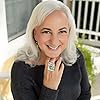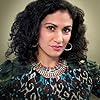Tara
asked
Chandra Prasad:
Congratulations on your upcoming YA novel. It looks fantastic. Where did the idea for this plot come from?
Chandra Prasad
Hi Tara,
Thanks for asking this thoughtful question. As a matter of fact, I recently wrote "The Story Behind the Book" for DAMSELFLY, which I've pasted below. Forgive the long length!
Warm wishes,
Chandra
The Story Behind the Book
Damsellfy
by Chandra Prasad
When I first read Lord of the Flies in 9th grade English glass, I found it riveting. The novel nibbled at my conscience and made me question the true state of human nature, which hitherto I had assumed to be (mostly) good. Some of the scarier sections wormed their way into my sleep, giving me nightmares. Yet I was pretty sure my teacher would manage to find a way to make Golding’s book boring. She had a knack for sucking the life out of literature with her cold, clinical presentation style.
As we started the LOTF unit, history seemed bound to repeat itself. The droning of her sounded like static. She listed literary devices with all the panache of robocaller selling used tires. But just when I was about to tune out completely, she uttered a remark that made me instantly alert.
“So you see, class, Golding’s island was a perfect microcosm of human society.”
A perfect microcosm? Seriously? The island couldn’t possibly be a “perfect” microcosm because—guess what?—there were no girls on it! Nor were there any people of color. Nor was there any class hierarchy, except maybe by age. All of the kids on the island fit more or less the same mold: white British schoolboys.
I didn’t speak up about my skepticism. But I still remember how frustrated I felt that my teacher didn’t see what seemed so obvious to me. Those unvoiced feelings of discontent and exasperation, which carried over into adulthood, were the inspiration for Damselfly. Since 9th grade, I’ve wanted to read (and write) a Lord of the Flies-esque novel that represents a more realistic and diverse society.
As with my other novels, I made a detailed outline of the plot. And as with my other novels, I veered off course from it almost immediately. Damselfly started out as an indirect response to Golding’s novel. I attempted to ask and answer some of the same questions Golding did, but with a more heterogeneous cast of characters. What happens when vulnerable young people are displaced and left to fend for themselves? Do they create new rules and order? Or does the very notion of civilization disintegrate? If violence and chaos reign, does that mean that human beings are naturally depraved? Is civilization just a cover-up for our savage instincts? Somewhere along the line, however, Damselfly became its own unique, self-contained, autonomous narrative that was less homage to LOTF than crucible for a whole different set of questions. Would girls would act and react differently than boys if placed in similarly terrifying circumstances? Would one sex take a position of leadership over the other? How much does race matter when we are removed from regular society? What about class?
Almost all of these questions are addressed by the protagonists of Damselfly. Samantha “Sam” Mishra and her best friend, Amelia “Mel” Sharpe, quickly emerge as the heart, soul, mind, and central nervous system of the novel. The reader experiences and interprets the world of Damselfly through their discussions, thoughts, and actions.
Sam was the easier of the two girls to create. She is mixed-race, observant, and possesses an uneasy sense of self. Her voice is not my voice, but it is one I knew well. Mel was different. In my notes, I wrote that she should have a little of the spirit and verve of the following characters:
1. Anne Shirley from Anne of Green Gables
2. Huckleberry Finn
3. Nancy Drew
4. Elizabeth from Pride and Prejudice
5. Encyclopedia Brown
6. Laura Ingalls from Little house on the prairie
7. Jo from Little Women
8. MacGyver (the inventive secret agent from the ‘80s television show that only olds will remember)
Not an easy recipe, to be sure! Happily, Mel Sharpe turned out to be not a cockamamie combination of all these characters, but a fully formed person in her own right. She is someone I wish I could have known when I was a kid. How refreshing it would have been to hang out with a someone who “cared not a lick how she looked;” who’d rather invent and discover new things than crush on boys; who was unmoved by bullying, peer pressure, popularity, and gossip. I didn’t know an Mel then, but I’m glad to have made her acquaintance now.
As for my ninth grade English teacher, I still don’t think she was right about that “perfect microcosm” thing. But you know what? No microcosm can be perfect. Each is destined to be as complicated, curious, relatable, and provocative and as the characters who inhabit it.
Thanks for asking this thoughtful question. As a matter of fact, I recently wrote "The Story Behind the Book" for DAMSELFLY, which I've pasted below. Forgive the long length!
Warm wishes,
Chandra
The Story Behind the Book
Damsellfy
by Chandra Prasad
When I first read Lord of the Flies in 9th grade English glass, I found it riveting. The novel nibbled at my conscience and made me question the true state of human nature, which hitherto I had assumed to be (mostly) good. Some of the scarier sections wormed their way into my sleep, giving me nightmares. Yet I was pretty sure my teacher would manage to find a way to make Golding’s book boring. She had a knack for sucking the life out of literature with her cold, clinical presentation style.
As we started the LOTF unit, history seemed bound to repeat itself. The droning of her sounded like static. She listed literary devices with all the panache of robocaller selling used tires. But just when I was about to tune out completely, she uttered a remark that made me instantly alert.
“So you see, class, Golding’s island was a perfect microcosm of human society.”
A perfect microcosm? Seriously? The island couldn’t possibly be a “perfect” microcosm because—guess what?—there were no girls on it! Nor were there any people of color. Nor was there any class hierarchy, except maybe by age. All of the kids on the island fit more or less the same mold: white British schoolboys.
I didn’t speak up about my skepticism. But I still remember how frustrated I felt that my teacher didn’t see what seemed so obvious to me. Those unvoiced feelings of discontent and exasperation, which carried over into adulthood, were the inspiration for Damselfly. Since 9th grade, I’ve wanted to read (and write) a Lord of the Flies-esque novel that represents a more realistic and diverse society.
As with my other novels, I made a detailed outline of the plot. And as with my other novels, I veered off course from it almost immediately. Damselfly started out as an indirect response to Golding’s novel. I attempted to ask and answer some of the same questions Golding did, but with a more heterogeneous cast of characters. What happens when vulnerable young people are displaced and left to fend for themselves? Do they create new rules and order? Or does the very notion of civilization disintegrate? If violence and chaos reign, does that mean that human beings are naturally depraved? Is civilization just a cover-up for our savage instincts? Somewhere along the line, however, Damselfly became its own unique, self-contained, autonomous narrative that was less homage to LOTF than crucible for a whole different set of questions. Would girls would act and react differently than boys if placed in similarly terrifying circumstances? Would one sex take a position of leadership over the other? How much does race matter when we are removed from regular society? What about class?
Almost all of these questions are addressed by the protagonists of Damselfly. Samantha “Sam” Mishra and her best friend, Amelia “Mel” Sharpe, quickly emerge as the heart, soul, mind, and central nervous system of the novel. The reader experiences and interprets the world of Damselfly through their discussions, thoughts, and actions.
Sam was the easier of the two girls to create. She is mixed-race, observant, and possesses an uneasy sense of self. Her voice is not my voice, but it is one I knew well. Mel was different. In my notes, I wrote that she should have a little of the spirit and verve of the following characters:
1. Anne Shirley from Anne of Green Gables
2. Huckleberry Finn
3. Nancy Drew
4. Elizabeth from Pride and Prejudice
5. Encyclopedia Brown
6. Laura Ingalls from Little house on the prairie
7. Jo from Little Women
8. MacGyver (the inventive secret agent from the ‘80s television show that only olds will remember)
Not an easy recipe, to be sure! Happily, Mel Sharpe turned out to be not a cockamamie combination of all these characters, but a fully formed person in her own right. She is someone I wish I could have known when I was a kid. How refreshing it would have been to hang out with a someone who “cared not a lick how she looked;” who’d rather invent and discover new things than crush on boys; who was unmoved by bullying, peer pressure, popularity, and gossip. I didn’t know an Mel then, but I’m glad to have made her acquaintance now.
As for my ninth grade English teacher, I still don’t think she was right about that “perfect microcosm” thing. But you know what? No microcosm can be perfect. Each is destined to be as complicated, curious, relatable, and provocative and as the characters who inhabit it.
About Goodreads Q&A
Ask and answer questions about books!
You can pose questions to the Goodreads community with Reader Q&A, or ask your favorite author a question with Ask the Author.
See Featured Authors Answering Questions
Learn more



Feb 28, 2018 12:44PM · flag
Mar 01, 2018 01:07PM · flag